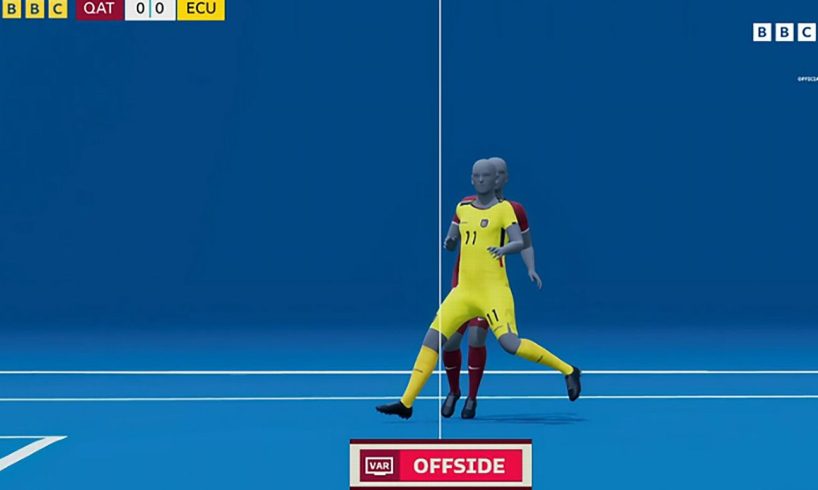
The Premier League has spent over 12 months testing a number of artificial intelligence (AI)-based semi-automated offside technology (SAOT) providers, and now it’s ready to be rolled out during the 2024-25 season.
UEFA first used SAOT in the Champions League from the start of the 2022-23 season group stage, quickly followed by FIFA for the World Cup in Qatar.
– Stream on ESPN+: LaLiga, Bundesliga, MLS, more (U.S.)
What is this new technology, how does it work, and is it really any better?
When will we see SAOT in the Premier League?
The Premier League has confirmed that it will introduce semi-automated VAR offside technology (SAOT) for the 2024-25 season — but it won’t be in place for the start of the campaign.
Editor’s Picks
2 Related
A statement read: “At a Premier League Shareholders’ meeting today, clubs unanimously agreed to the introduction of Semi-Automated Offside Technology.
“The new system will be used for the first time in the Premier League next season, and it is anticipated the technology will be ready to be introduced after one of the Autumn international breaks.
“The technology will provide quicker and consistent placement of the virtual offside line, based on optical player tracking, and will produce high-quality broadcast graphics to ensure an enhanced in-stadium and broadcast experience for supporters.”
Why not at the start of the 2024-25 season?
A source has told ESPN that the Premier League is to part ways with Hawk-Eye, the current provider of offside technology, and the replacement company will not be ready with SAOT in August as additional testing is required.
Extensive trials and analysis has been conducted throughout this season but SAOT will not be available until after one of the three autumn international breaks — though there’s no confirmation if that will be in September, October or November as the Premier League wants to be sure the technology is reliable.
Is SAOT in any other leagues?
Serie A was the first European domestic league to switch to SOAT, introducing it in January 2023 after a high-profile VAR error early in that campaign had seen a stoppage-time winning goal for Juventus incorrectly disallowed. Mexico’s Liga BBVA MX also introduced it in January 2023, and it has been used in the CONMEBOL Libertadores, South America’s Champions League.
LaLiga had already announced it would introduce SAOT for the 2024-25 season.
Why does VAR offside need to change?
Long delays, perceived inaccuracies and a lack of confidence in the system among fans, players and coaches. And that’s just for starters.
Scepticism also comes from the poor visualisation of decisions, with lines placed on the pitch which cannot replace a person’s own perspective of an offside decision on a camera angle. A player may look onside, but the technology says they are offside.
So, what does the Premier League hope to solve?
Firstly, selecting the exact point the ball is touched by the passer cannot be determined accurately because of the frame rate of TV cameras (50 frames per second) used across all major leagues.
Secondly, the VAR manually selects the farthest forward point on both defender and attacker (or the ball if applicable), which cannot be applied consistently.
The time taken to judge offside, in some cases up to five minutes for complex decisions, adds further frustration.
All in all, supporters don’t really trust the process as it works now — not helped by a number of high-profile errors.
In February, the VAR had failed to identify that a Brentford player was offside in the buildup to a goal at Arsenal. On the same day, the lines had been placed on the wrong Crystal Palace defender, leading to a Brighton & Hove Albion goal incorrectly being disallowed.
And in October, Liverpool had a goal ruled out for offside on the field at Tottenham Hotspur which the VAR mistakenly failed to correct. However, the error on the Luis Díaz goal was primarily around communication rather than the technology — an issue SAOT would not be able to fix by itself but a less complicated process may help prevent it.
So why is semi-automated offside technology better?
SAOT automates the process outlined above and produces a result in a much quicker timeframe. It removes all subjectivity from these two parts of the process, meaning there is no human role. The Premier League believes the average time taken for an offside VAR review will be cut by 31 seconds.
The Premier League is also confident that SAOT will increase confidence in decision making by reducing the reliance on checking all potential offsides — therefore reducing the likelihood that a potential offside decision is missed by VAR.
The semi-automated part comes in because the VAR still has to validate the offside decision — the technology cannot tell if an attacker is actively involved in play or confirm the ball was touched by a teammate of that player.
A visualisation of a goal ruled out for offside at the World Cup. BBC
How will it work?
There will be 10 bespoke cameras installed under the roof of the 20 Premier League League grounds. These cameras provide optimal tracking for all 22 players, recording 29 data points on all limbs and extremities that are relevant for an offside decision — including the upper arm, toes, knees and head — so the system knows the exact position of a player at any given moment.
All player and ball data is processed in real time by AI, which triggers an alert to the VAR when an offside has been detected. The VAR must then validate that the kick point and offside line are accurate, and the offside player is active, and then inform the referee who can confirm or change the on-field decision.
The referee will still have to go to the pitchside monitor if there is a subjective offside decision (for instance an attacker in the goalkeeper’s line of sight) to be changed.
However, there’s a difference between the system used by FIFA at the World Cup, which uses a sensor inside the match ball to drastically improve the accuracy of the kick point.
The Premier League — along with the other top European leagues and the Champions League — does not have a sensor inside the ball or on the players, but the AI will compensate for this.
The optical tracking system maps the players but also the ball during the entire match. It works at 50fps (1 frame every 0.02 seconds), the same as the offside tech we see in the domestic leagues, but it should be able to identify any change of direction of the ball.
Between the frames the AI is able to interpolate both the player and ball movements with the system providing a continuous flow of data.
More accurate? So are we going back to ‘toenail offsides’?
This was always the fear when a more accurate system was first spoken of. Right now, VAR offside has a tolerance level, or “benefit of the doubt,” due to flaws in the process around accuracy and consistency. That “benefit of the doubt” is to be removed, with decisions based upon the result delivered to the VAR.
It means we seem set to go back to the incredibly marginal offside decisions we saw when VAR was first introduced.
So how can we tell a player really is offside?
This is as important as any other part of this project. It was incredibly difficult for fans to visualise offside decisions, and now fans will effectively be moved in line with the assistant referee to show an offside.
Much like goal-line technology, a 3D animation is created that will be shown at the stadium and on TV.
The exact point on the attacker which is deemed offside is highlighted, and a simulation will then move in line with the players.
It is far more understandable for fans at the ground and watching on television.
There will be a new 3D animation to show an offside decision — but there may be more marginal calls. FIFA
So no more long delays?
They will certainly be more rare, because SAOT means the VAR won’t have to go through the manual process of setting up the decision.
However, there will be occasions when there are subjective elements to a decision. Is a player interfering with play? Has there been a “deliberate play” of the ball by the defender? Is an attacker in the line of vision of the goalkeeper? Those decisions, and others with multiple offside elements, will take longer.
Added to that, as this is new technology the Premier League does want decisions to be checked rather than taken on faith, only for a mistake to be found.
Great, so fans can celebrate goals again?
Could we get back to a situation whereby the first thought in a fan’s mind is no longer the fear of a goal being disallowed or subjected to a lengthy check? With the new technology, that’s part of the plan but we’re a long way from it — though this will be better.
All goals and penalty decisions have to be checked for offside. It still means the vast majority of decisions are subject to offside checks. That it will get quicker is great, but will it be quick enough?
That said, many checks should take place in the background without any impact. We can only really judge the psychological impact on supporters once we’ve seen it in action in the Premier League.
In Serie A there has still been controversy over the tight offside decisions, but fewer complaints overall.
What about the delayed offside flag?
While it’s true SAOT can work player positions quickly, the time required for the VAR to validate decisions means that we haven’t seen the end of the delayed offside flag.
Play will still continue in an attacking situation until the end of the phase, when the assistant will raise his flag.
Will SAOT be used for all offside decisions?
The technology provides for all potential offsides to be alerted to the VAR. However, this information will only be validated and communicated to the referee on pitch in case of one of the usual defined match-changing moments covered by VAR — goals, penalties and red cards.
So if an offside is detected before a corner or a free kick, which hasn’t been flagged by the assistant referee, the VAR will not alert the referee and offside will not be penalised.






